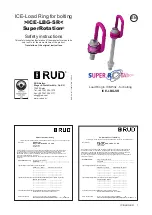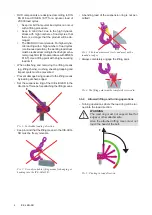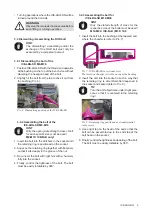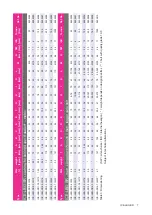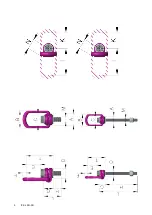
3
ICE-LBG-SR
• If the VLBG is used exclusively for lashing, the va-
lue of the working load limit can be doubled.
LC = permissible lashing capacity = 2 x WLL
HINT
If the ICE-LBG-SR is or was used as a
lashing point, it must not be used for lifting
later on!
3.2 Hints for the assembly
Basically essential:
• The material construction to which the lifting point
will be attached should be of adequate strength to
withstand forces during lifting without deformation.
The German testing authority BG/DGUV, recom-
mends the following minimum for bolt lengths:
1x
M in steel
(minimum quality S235JR [1.0037])
1.25x M in cast iron (however when castings of
lower strength (<200 MPa) are used the
thread engagement has to be at least
1.5 x d)
2x M in aluminum alloys
2.5x M in light metals of low strength
(M = thread size, e.g. M20)
• When lifting light metals, nonferrous heavy metals
and gray cast iron the thread has to be chosen in
such a way that the working load limit of the thread
corresponds to the requirements of the respective
base material.
• ICE-LBG-SR lifting points must be positioned at
the load in such a way that improper loading like
turning or twisting of the load will be avoided:
•
For single leg lifts:
Load ring should be
positioned vertically above the centre of
gravity.
•
For two leg lifts:
Lifting points must be
positioned on both sides and above the centre
of gravity.
•
For three and four leg lifts:
Lifting points
should be arranged equally in a plain level
around centre of gravity.
• Symmetry of loading:
Determine the working load limit of each individual
RUD lifting point for symmetrical and unsymme-
trical loading according to the following physical
formula:
W
LL
= working load limit (kg)
G
= load weight (kg)
n = number of load bearing legs
ß
= angle of inclination of the chain to the vertical
W
LL
=
G
n x cos ß
Number of load bearing strands
Symetrical
Unsymetrical
Double leg
2
1
Three/four leg
3
1
Table 1: Load bearing strands (compare also with
Table 2)
HINT
With unsymmetrical loads, the WLL of each
Lifting Point must be the same as the
weight of the load.
• A plane bolt-on surface (ØD, table 3) with a
perpendicular thread hole must be guaranteed.
The thread must be carried out acc. to DIN 76
(countersink max. 1.05xd).
The holes must be drilled with a sufficient depth in
order to guarantee compatibility with the supporting
surface. Machine through holes up to DIN EN
20273-middle.
• The ICE-LBG-SR must be rotatable by 360° when
installed. Please observe the following:
• For a
one-time transport, or a turning action
and flipping of a load
, tightening by hand with
a spanner is sufficient. Lifting point must be
fully engaged into thread hole and the bearing
surface must sit properly at the bolt-on area of
the load.
• For
long term application
the ICE-LBG-SR
must be tightened with torque according to
table 3 (+/- 10 %).
• If used
multiple times for transporting, tur-
ning or flipping under load
, it is necessary to
tighten the ICE-LBG-SR with a torque moment
(+/- 10 %) according to table 3.
• With shock loading or vibrations, especially at
through hole fixtures with a nut at the end of
the bolt, accidential release can occure.
Securing possibilities:
Observe torque moment,
use liquid securing glue f.e. Loctite (can be adap-
ted to the usage, observe manufacturer hints) or
assemble a form closure bolt locking device f.e. a
castle nut with cotter pin, locknut etc.
• Finally check the proper assembly (see chapter 4
Inspection / repair
).
3.3 Hints for the usage
3.3.1 General information for the usage
• Always regularly observe the appearance of the
whole lifting point (e.g. fixed lifting point/slings)
before using it (secured bolt seat, strong corrosion,
cracks on load-bearing parts, deformations). Refer
to chapter 4
Inspection / repair.
ATTENTION
Wrong assembled or damaged ICE-LBG-
SR as well as improper use can lead to
injuries of persons and damage of objects
when load drops.
Please inspect all ICE-LBG-SR carefully
before each use.
Summary of Contents for SuperRotation ICE-LBG-SR
Page 8: ...8 ICE LBG SR...

